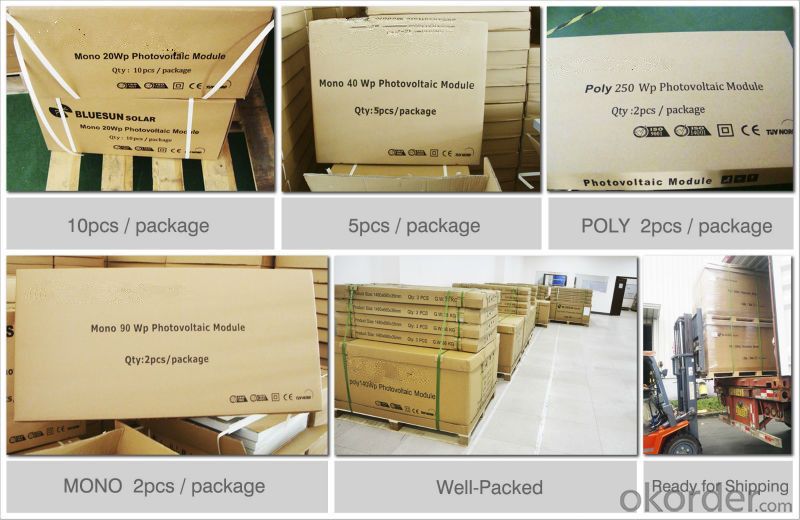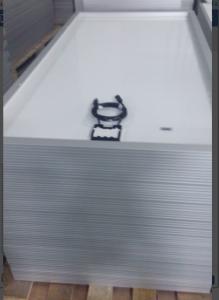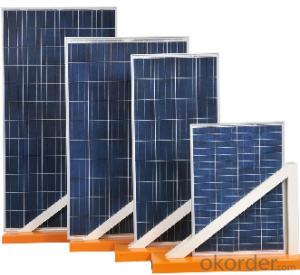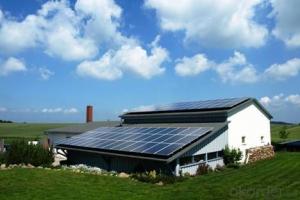500w Solar Panels with TUV CEC Certificates
- Loading Port:
- Shanghai
- Payment Terms:
- TT OR LC
- Min Order Qty:
- 1000 watt
- Supply Capability:
- 100000000 watt/month
OKorder Service Pledge
OKorder Financial Service
You Might Also Like
Specification
300W Solar Panel with TUV CEC Certificates
- TUV IEC, MCS (UK), CE, CEC (Australia), INMETRO, IDCOL, SONCAP CERTIFIED
- [EU ANTIDUMPING DUTY-FREE]
- PROFESSIONAL SOLAR PANEL MANUFACTURER SINCE 2004
FEATURES
`Long Service Life
`High Efficency Solar Cells
`Special Aluminum Frame Design
`High Transmission,Low Iron Tempered Glass - TUV IEC, MCS (UK), CE, CEC (Australia), INMETRO, IDCOL, SONCAP CERTIFIED
- [EU ANTIDUMPING DUTY-FREE]
- PROFESSIONAL SOLAR PANEL MANUFACTURER SINCE 2004
FEATURES
`Long Service Life
`High Efficency Solar Cells
`Special Aluminum Frame Design
`High Transmission,Low Iron Tempered Glass
`Advanced Cell Encapsulation
APPLICATIONS
`Solar power stations
`Rural electrification, Small home power systems
`Power supply for traffic, security, gas industry
`12V and 24V battery charging system
`Other industrial and commercial applications

| ELECTRICAL CHARACTERISTICS | |||||||
| Model Number | KM(P)275 | KM(P)280 | KM(P)285 | KM(P)290 | KM(P)295 | KM(P)300 | |
| Maximum Power as per STC | Pmax(W) | 275 | 280 | 285 | 290 | 295 | 300 |
| Power Tolerance | % | ±3% | |||||
| Maximum Power Voltage | Vm(V) | 36.43 | 36.56 | 36.72 | 36.79 | 36.93 | 37.15 |
| Maximum Power Current | Im(A) | 7.55 | 7.66 | 7.77 | 7.89 | 7.99 | 8.08 |
| Open Circuit Voltage | Voc(V) | 43.7 | 42.92 | 44.06 | 44.21 | 44.35 | 44.5 |
| Short Circuit Current | Isc(A) | 8.1 | 8.17 | 8.23 | 8.33 | 8.41 | 8.72 |
| Maximum System Voltage | VDC | 1000 | |||||
| Cell Efficiency | % | 15.7 | 16.0 | 16.3 | 16.6 | 16.8 | 17.1 |
| Module Efficiency | % | 14.2 | 14.5 | 14.7 | 15.0 | 15.2 | 15.5 |
| Cells per Module | Pcs | 72 | |||||
| Cell Type | Polycrystalline silicon | ||||||
| Cell Size | mm | 156 x 156 | |||||
| Bypass Diodes | Pcs | 12Amp, 6 pcs | |||||
| Max. Series Fuse Rating | A | 15A | |||||
| Temperature coefficient of Isc | %/°C | 0.05 | |||||
| Temperature coefficient of Voc | %/°C | -0.35 | |||||
| Temperature coefficient of power | %/°C | -0.47 | |||||
| NOCT- Nominal operating cell temperature | °C | 47 ± 2 | |||||
| Operating Temperature | °C | -40 ~ +85 | |||||
| MECHANICAL CHARACTERISTICS | |||||||
| Dimensions | mm | 1954 x 990 x 50 | |||||
| Weight | Kg | 23.5 | |||||
| Type of Junction Box | TUV certified, IP65 | ||||||
| Cable Type, Diameter | TUV certified, 4mm2, 90 cm in length | ||||||
| Connector | compatible to Type 4 (MC4) | ||||||
| Tempered Glass | 3.2 mm, high transmission, low iron | ||||||
 Packing
Packing

FAQ
1. What kind of Solar Cells does it have
---poly crystalline 156*156mm and 125*125mm or mono 125*125mm and 156*156mm
2. Is the front panel Glass or Plastic
---Tempered glass 3.2mm thickness or adjust to what you need, Light transmittance up to 95%.
3. Does it meet Europe Standards for Solar Energy
---This is TUV approval products, all the producing procedure apply TUV&UL.
4. What is the Efficiency level
--- Between 16-18.9% for solar cells.
5. What is the Nominal Voltage
--- 18v 20v 24v 36v 30v 48v , and so on, we can adjust to what you need.
6. What is the Warranty Period, How many years?
Power efficiency warranty:
---90% in 10 years; 80% in 25 years.
- Q: solar energy
- Himin solar pay more attention to the products quality, we would like to talk more about the quality characteristic of solar module,The credibility of the supplier and the quality of raw material are very important. Himin choose top material to make our solar panels.
- Q: Is there a free site or resource that will teach you how to do this? Hopefully step by step and tells you how to buy all the parts ect?Which is the best resource for sale earth4energy, homemadeenergy, ect? Do they actually work and also as well as those which are professionally done?They say it will cost under $200 for a panel, but how much will this panel actually produce I mean how many panels would you have to make to produce 00% of your homes energy?
- Earth4Energy okorder /
- Q: HIToday i was using my BB gun and shot my dads solar panel. I want to fix it for him because he spent a lot of time trying to get the solar panels. All i broke was the glass on the front, what is the glass and where can i buy new glass for it?
- Note: he didnt buy them, we found them at a property that we bought
- Q: Can solar panels be installed on a prison or correctional facility?
- Yes, solar panels can be installed on a prison or correctional facility. Installing solar panels can help reduce the facility's reliance on traditional energy sources and lower its carbon footprint. Additionally, it can save money on electricity costs in the long run. However, there may be certain security considerations and regulations that need to be addressed to ensure the panels do not pose any risks or vulnerabilities.
- Q: Can solar panels power my entire home?
- Yes, solar panels can power your entire home. However, the feasibility of this depends on various factors such as the size of your home, the amount of sunlight available in your area, the efficiency and capacity of the solar panels, and your energy consumption patterns. It is recommended to consult with a professional to assess your specific needs and design a solar system that can meet the energy requirements of your entire home.
- Q: I bought a pack of OEM mini solar panels that produce 4.2v and 22mA and I was just wondering how many LED's I could hook up to one mini solar panel? I currently have one green LED with a resistor on the one panel but was wondering how many I could possibly run off of one panel?
- Typically LED's run off low voltage and 20mA or so of power (it depends what kind of led you have). That being said if one of your solar panels only provides 22mA of power then your circuit would have to be a series circuit for you to connect more than one. In a series circuit the current supplied of 22mA will go through each LED whereas a parallel circuit the current would be divided for each subsequential led. So in your case i can see you getting away with 3 or so led's before the voltage drop across each led will cause the voltage to be insufficient enough to drive anymore. Keep in mind the LED's will turn on but the first one will be bright then next one not as bright and so on. If you opted out and bought a solar panel with 200mA and 4V you could wire the led's in parallel and get 0 led's to turn on with the same brightness or intensity. Hoped that helped!
- Q: How do solar panels affect the property's overall sustainability?
- Solar panels can significantly enhance a property's overall sustainability by harnessing renewable energy from the sun. They reduce dependence on fossil fuels, decrease carbon emissions, and contribute to energy independence. Additionally, solar panels can generate surplus electricity that can be sold back to the grid, further enhancing the property's sustainability and potentially providing financial benefits.
- Q: I want to install solar panels in my roof and most installers don't recommend any particular brand. Do you have experience with any particular brand that has worked for you or anybody you know? Does the brand of the panel make a difference?
- Mitsubishi panels have served us well for 3 years so far, no problems. Kyocera had a well-known problem many years ago, but they lived up to the warranty and replaced defective panels. Their current products are considred good. I like the value delivered by Suntech panels. Might be a best buy - shop around. I have not heard about any of the major brands having trouble, lately. If you're intending to connect to the grid, be cautious about used or blemished panels. While they might work fine, they usually are ineligible for rebates.
- Q: Home depot has solar panels but they are so expensive? were is the best place to get them?
- It okorder to locate a solar specialist in your area. Be sure to ask them about any state or local tax incentives for installing home solar. This can really drop your costs.
- Q: i really need to know howbecause im building a solar powered car for science fair :]thank you!
- get some stuff, put it on the other stuff
Send your message to us
500w Solar Panels with TUV CEC Certificates
- Loading Port:
- Shanghai
- Payment Terms:
- TT OR LC
- Min Order Qty:
- 1000 watt
- Supply Capability:
- 100000000 watt/month
OKorder Service Pledge
OKorder Financial Service
Similar products
Hot products
Hot Searches
Related keywords




























